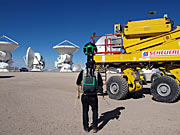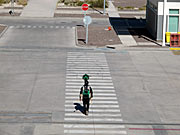Anuncio
Todos los observatorios de ESO disponibles en Google Street View
10 de Junio de 2014
Los observatorios astronómicos de ESO, en Paranal, La Silla y el Atacama Large Millimeter/submillimeter Array (ALMA), se han incluído en las espectaculares vistas panorámicas, en 360 grados, de Google Street View quedando disponibles, desde ahora, en Google Maps.
El equipo de Google Street View visitó los tres sitios astronómicos de nivel mundial de ESO en Chile: el Observatorio Paranal, ubicado a 2635 metros de altura, que alberga al VLT, la instalación emblemática de ESO; El Observatorio La Silla, el primer observatorio de ESO ubicado a 2400 metros sobre el nivel del mar, en los bordes del Desierto de Atacama, como también los dos lugares de ALMA, vale decir, el Sitio de Operaciones del Conjunto (AOS por sus siglas en inglés), situado en el Llano de Chajnantor, a 5000 metros sobre el nivel del mar, como también el campamento internacional de ALMA denominado Centro de Apoyo a las Operaciones (OSF), a 2900 metros de altura.
En vez de usar los reconocidos autos Google Street, la compañía ahora tiene la capacidad de cubrir localidades remotas y de gran altitud gracias a los dispositivos Google Trekker. Estos instrumentos especiales de Google incluyen, en su parte central, una mochila de 18 Kgs, con 15 lentes orientados en diferentes direcciones, de modo que las imágenes puedan integrarse en vistas de 360 grados. Conforme el operador camina, se toman imágenes de notable calidad, aproximadamente cada 2.5 segundos.
Google Street View ahora permite que todos puedan explorar cada uno de estos tres observatorios desde sus propios hogares, y sumergirse bajo los telescopios de calidad mundial de ESO. Los espectadores pueden colocarse en la plataforma del VLT en medio de los cuatro Telescopios Unitarios (UTs) de 8.2mt de diámetro, o los cuatro Telescopios Auxiliares de 1.8-metros (ATs) que componen el ESO Very Large Telescope Interferometer (VLTI) o Interferómetro VLTI; Pueden dar una mirada panorámica a La Silla, donde ESO opera dos de los telescopios de 4 metros más productivos del mundo, el New Technology Telescope (NTT) y el Telescopio de 3.6 metros de ESO, como también aventurarse en las alturas extremas del Llano de Chajnantor, en una helada escena que rodea las diversas antenas que componen el Conjunto ALMA.
Además de los observatorios de ESO, Google Street View -que capta imágenes de Chile desde 2012- ha incorporado otras atracciones turísticas como, por ejemplo, la Reserva Huilo-Huilo en el sur de Chile y la Oficina Salitrera Humberstone en el norte de Chile. Otro lugar destacado incluido es una de las carreteras a mayor altura del mundo, la Ruta 27 de Chile. Otros sitios adicionales en el país estarán disponibles dentro del próximo año.
El acceso a los observatorios de ESO, a través de Google Street View, se encuentra en:
- Sitio de Operaciones del Conjunto ALMA (AOS)
- Centro de Apoyo a las Operaciones de ALMA (OSF)
- Observatorio Paranal
- Observatorio La Silla
Si usted desea una visión con mayor detalle de las instalaciones de ESO, visite el sitio ESO Virtual Tours que muestra las instalaciones en Chile y la Sede Central de ESO, en Garching, Alemania:
Notas
El Atacama Large Millimeter/submillimeter Array (ALMA), una instalación astronómica internacional, es una asociación entre Europa, Norteamérica y Asia del Este en cooperación con la República de Chile. ALMA es financiado en Europa por la Organización Europea para la Investigación Astronómica en el Hemisferio Austral (ESO), en Norteamérica por la Fundación Nacional de Ciencias de EE.UU. (NSF), en cooperación con el Consejo Nacional de Investigaciones de Canadá (NRC), y en Asia del Este por los Institutos Nacionales de Ciencias Naturales (NINS) de Japón en colaboración con la Academia Sinica (AS) en Taiwán. La construcción y operaciones de ALMA a nombre de Europa se encuentran a cargo de ESO, a nombre de Norteamérica son responsabilidad del Observatorio Radio Astronómico Nacional (NRAO), operado por Associated Universities, Inc.(AUI), y a nombre de Asia del Este corresponden al Observatorio Astronómico Nacional de Japón (NAOJ). El Observatorio ALMA tiene como labor la unificación del proyecto, y es el responsable de la dirección general y la gestión de la construcción, así como de la puesta en marcha y las operaciones del observatorio.
Contactos
Lars Lindberg Christensen
Jefe del Departamento de Educación y Difusión de ESO
ESO ePOD, Garching, Alemania
Tel: +49 89 3200 6761
Teléfono celular: +49 173 3872 621
Correo electrónico: lars@eso.org
Sobre el anuncio
| Identificador: | ann14047 |
Our use of Cookies
We use cookies that are essential for accessing our websites and using our services. We also use cookies to analyse, measure and improve our websites’ performance, to enable content sharing via social media and to display media content hosted on third-party platforms.
ESO Cookies Policy
The European Organisation for Astronomical Research in the Southern Hemisphere (ESO) is the pre-eminent intergovernmental science and technology organisation in astronomy. It carries out an ambitious programme focused on the design, construction and operation of powerful ground-based observing facilities for astronomy.
This Cookies Policy is intended to provide clarity by outlining the cookies used on the ESO public websites, their functions, the options you have for controlling them, and the ways you can contact us for additional details.
What are cookies?
Cookies are small pieces of data stored on your device by websites you visit. They serve various purposes, such as remembering login credentials and preferences and enhance your browsing experience.
Categories of cookies we use
Essential cookies (always active): These cookies are strictly necessary for the proper functioning of our website. Without these cookies, the website cannot operate correctly, and certain services, such as logging in or accessing secure areas, may not be available; because they are essential for the website’s operation, they cannot be disabled.
Functional Cookies: These cookies enhance your browsing experience by enabling additional features and personalization, such as remembering your preferences and settings. While not strictly necessary for the website to function, they improve usability and convenience; these cookies are only placed if you provide your consent.
Analytics cookies: These cookies collect information about how visitors interact with our website, such as which pages are visited most often and how users navigate the site. This data helps us improve website performance, optimize content, and enhance the user experience; these cookies are only placed if you provide your consent. We use the following analytics cookies.
Matomo Cookies:
This website uses Matomo (formerly Piwik), an open source software which enables the statistical analysis of website visits. Matomo uses cookies (text files) which are saved on your computer and which allow us to analyze how you use our website. The website user information generated by the cookies will only be saved on the servers of our IT Department. We use this information to analyze www.eso.org visits and to prepare reports on website activities. These data will not be disclosed to third parties.
On behalf of ESO, Matomo will use this information for the purpose of evaluating your use of the website, compiling reports on website activity and providing other services relating to website activity and internet usage.
Matomo cookies settings:
Additional Third-party cookies on ESO websites: some of our pages display content from external providers, e.g. YouTube.
Such third-party services are outside of ESO control and may, at any time, change their terms of service, use of cookies, etc.
YouTube: Some videos on the ESO website are embedded from ESO’s official YouTube channel. We have enabled YouTube’s privacy-enhanced mode, meaning that no cookies are set unless the user actively clicks on the video to play it. Additionally, in this mode, YouTube does not store any personally identifiable cookie data for embedded video playbacks. For more details, please refer to YouTube’s embedding videos information page.
Cookies can also be classified based on the following elements.
Regarding the domain, there are:
- First-party cookies, set by the website you are currently visiting. They are stored by the same domain that you are browsing and are used to enhance your experience on that site;
- Third-party cookies, set by a domain other than the one you are currently visiting.
As for their duration, cookies can be:
- Browser-session cookies, which are deleted when the user closes the browser;
- Stored cookies, which stay on the user's device for a predetermined period of time.
How to manage cookies
Cookie settings: You can modify your cookie choices for the ESO webpages at any time by clicking on the link Cookie settings at the bottom of any page.
In your browser: If you wish to delete cookies or instruct your browser to delete or block cookies by default, please visit the help pages of your browser:
Please be aware that if you delete or decline cookies, certain functionalities of our website may be not be available and your browsing experience may be affected.
You can set most browsers to prevent any cookies being placed on your device, but you may then have to manually adjust some preferences every time you visit a site/page. And some services and functionalities may not work properly at all (e.g. profile logging-in, shop check out).
Updates to the ESO Cookies Policy
The ESO Cookies Policy may be subject to future updates, which will be made available on this page.
Additional information
For any queries related to cookies, please contact: pdprATesoDOTorg.
As ESO public webpages are managed by our Department of Communication, your questions will be dealt with the support of the said Department.


